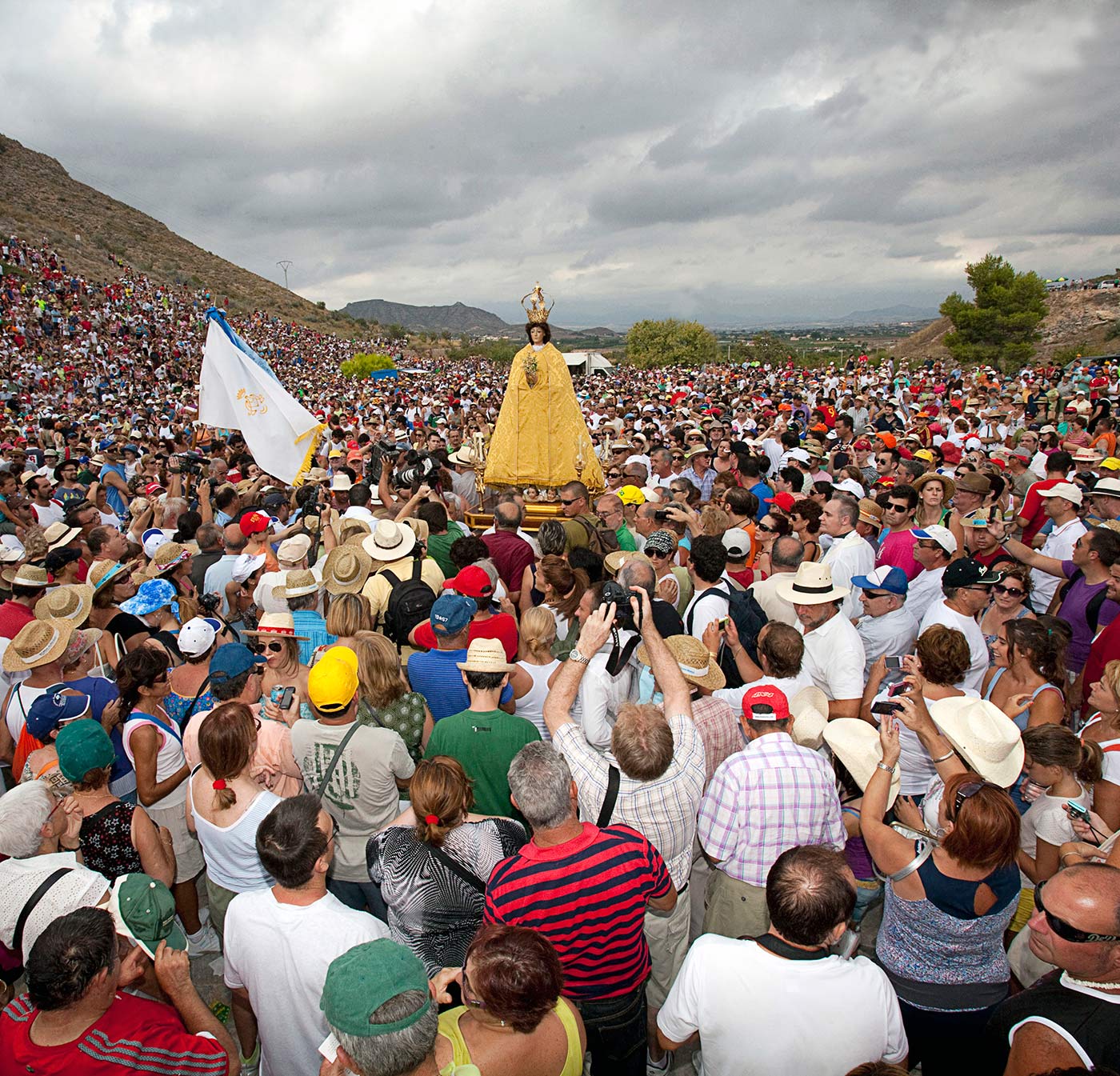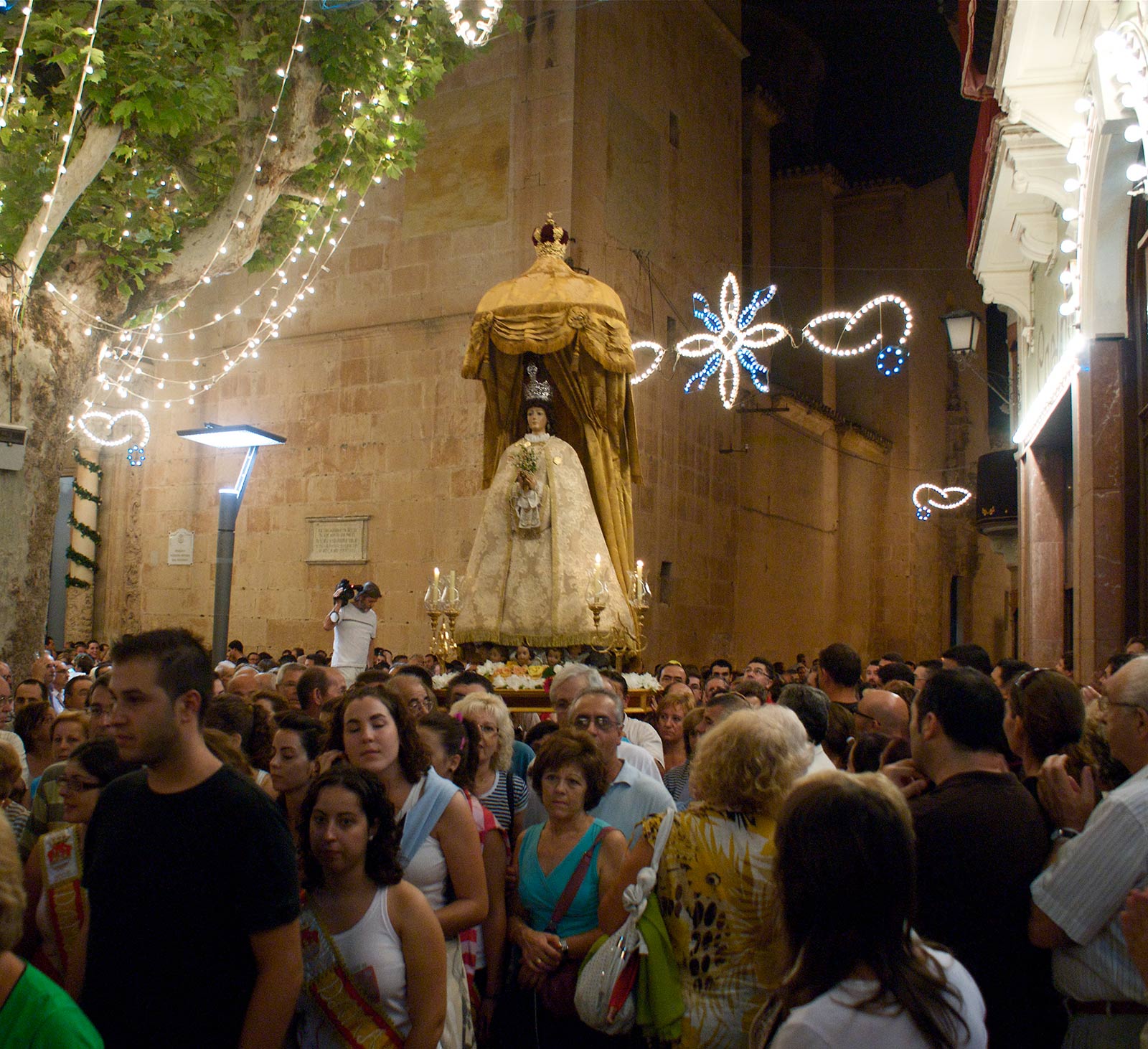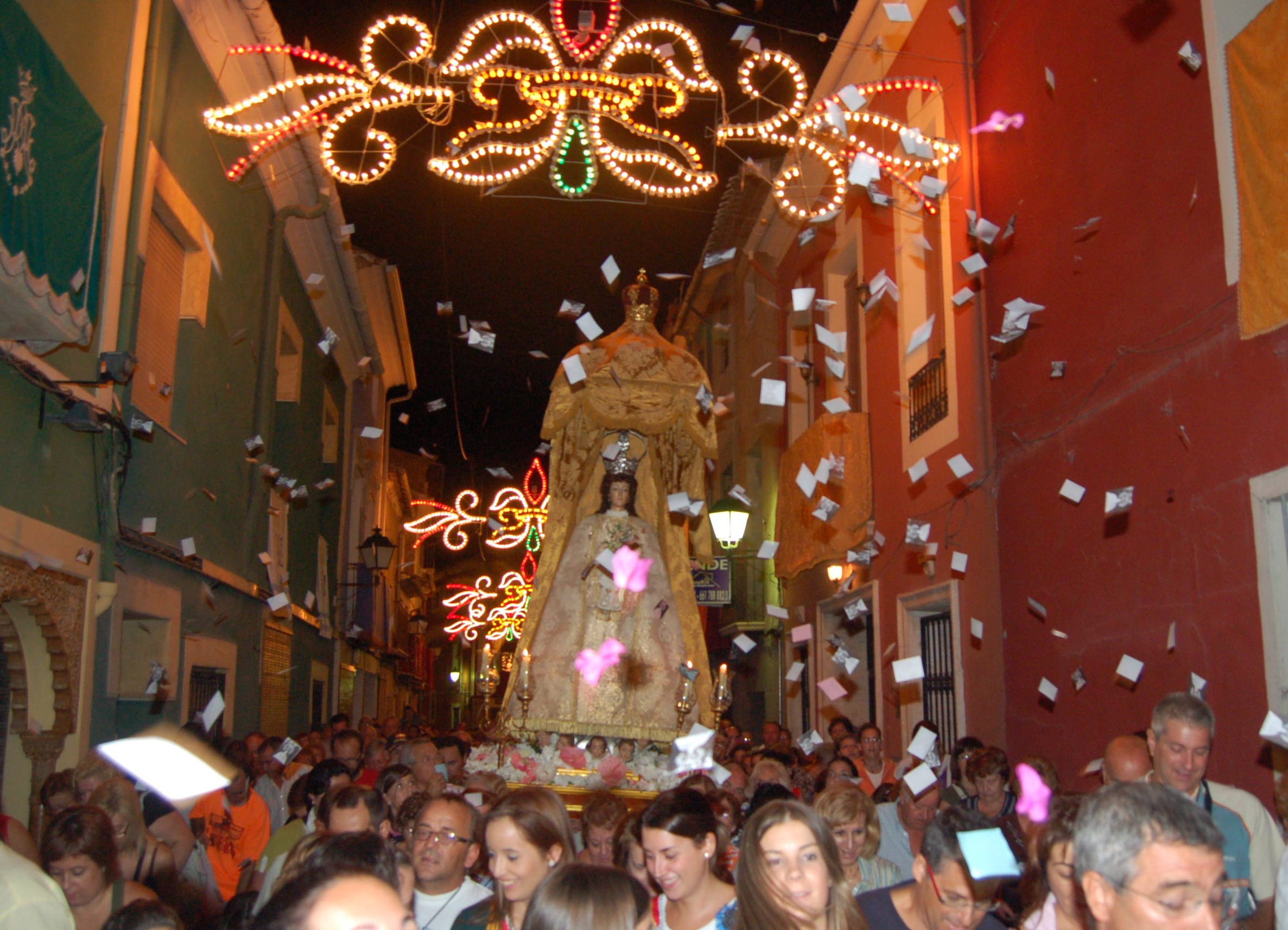“At 3pm on any 3rd August in an even numbered year”
This is the phrase that marks the commencement of Aspe’s long awaited celebrations in honour of its patron, Our Virgen de las Nieves. From that moment onwards, there is a succession of events carrying a strong tradition that are deeply rooted in the local population. These are indeed unique, unrepeatable and highly awaited moments, since Aspe, unlike the rest of Spanish towns and cities, only holds these celebrations in honour of its Patron every other year, on even numbered years.
Our Virgen de las Nieves is the symbol of an important tradition preserved by generation after generation of our predecessors who lived in Aspe and Hondon de las Nieves over the last six centuries. Among its most particular features, we can highlight the fact that both towns share the same Patron, therefore alternating the celebrations in her honour. But more specifically, the massive affection provoked by the Virgin also known as Serranica for centuries in so many thousands of people, to become an undoubted mark of identity for both towns of Aspe and Hondon de las Nieves.
In 2018, Pope Francis granted a Jubilee Year on the occasion of the 600th anniversary of the first appearance of our Virgen de las Nieves.
APPEARANCE OF OUR VIRGEN DE LAS NIEVES
Juan Pedro Asencio Calatayud, a previous official chronicler for the town of Aspe and Publications Director of “Virgen de las Nieves” Trust, collected a series of articles under the title: News and documents regarding the holy tradition professed to its venerable patron Our Holy Virgen de las Nieves by the towns of Aspe and Hondon. Among the articles listed in the Holy Tradition of Our Virgen de las Nieves, Patron of Aspe and Hondon, he summarised the origins of these celebrations that, due to their interest, we transcribe below:
“The holy tradition of Our Virgen de las Nieves, patron of the towns of Aspe and Hondon where it is venerated represents one of the most suggestive Marian traditions, not only in our diocese, but in the whole of Spain.
La veneración de la Imagen de la “Serranica”, como popularmente es llamada por sus fervorosos hijos de ambos pueblos, se remonta al siglo XV, y hasta nuestros días ha supuesto una larga y rica historia de sucesos, anécdotas, prodigios e incluso a veces enfrentamientos, pues época hubo en que Hondón y Aspe rivalizaron por ser únicos beneficiarios del patronazgo de tan amada Madre, María de las Nieves.
El origen de la Imagen de la Virgen de las Nieves, que se venera en las poblaciones de Hondón y Aspe, posee una singular y piadosa tradición oral que se ha transmitido, de generación en generación, durante cerca de seis siglos. Supone una pequeña crónica eminentemente popular. Nació del pueblo y vive en el pueblo. Los eruditos la han plasmado en bellas páginas literarias y los poetas han hecho de su relato un verdadero romance épico-religioso.


Popularly known as the “Serranica” by the fervent sons of both towns, this image has been venerated since the 15th century to our present day. A truly lengthy and rich history of events, anecdotes, prodigies and, in some cases, confrontation during the period when Hondon and Aspe became rivals in their quest to become the sole beneficiaries of the patronage of their so beloved Mother, Our Virgen de las Nieves.
Venerated in the towns of Hondon and Aspe, the origins of the image of Our Virgen de las Nieves are surrounded by a unique and pious oral tradition transmitted from one generation to the next for almost six centuries. It represents a small and decidedly popular chronicle that was created by and lives among its people. Scholars have captured the story in delightful literary pages, while poets have turned its tale into an epic religious romance.
At sunset on the 5th August 1418, some villagers at Hondon hermitage square were commenting on an order received from Aspe, ready to travel to Biar in order to bow at Our Virgen de Gracia requesting her protection. That was when they saw two young pilgrims who asked them for the way to Yecla. The villagers replied that it was too far away and offered them accommodation, advising that they should not continue marching. So the pilgrims accepted, and they continued to discuss their journey to Biar. When the pilgrims realised how keen the villagers were to have an image of the Virgin, and in view of their knowledge regarding sculpture, they offered to create an image for them. In order to do so, they requested to be locked up alone in the hermitage. On the following day, the hermitage remained locked and no noises could be heard to imply that they were still working inside. On the dawn of Thursday 9th August, the villagers could no longer resist their curiosity and, while also worried about the pilgrims’ fate, all labourers who were present were authorised by the Parish Major and the Hermitage Chaplain Mosen Esteban Pantoja to break the lock and open the gates.
With great admiration, they found the new image of the Virgin Mary on the only altar dedicated to Our Virgen del Rosario. And although nobody was striking it, the hermitage bell was jumping incessantly for a period of three hours. Any food left for the pilgrims remained untouched, and they had disappeared and were never seen again.
After the announcement was made in Aspe, a large crowd of locals including the Priest and the town hall authorities travelled to Hondon full of hope and excitement. In order to decide the name of the Holy Image, they made small cards with the following names: María de la Piedad, María de la Victoria, Refugio de Afligidos, María del Consuelo, y Concepción Inmaculada.. These were placed inside a glass tumbler, but the one that was picked at random had the name of Our Virgen de las Nieves in it, a title that had not been written on any of the cards. So the same process was repeated up to three times, and every time the name of Our Virgen de las Nieves was picked. From the year of 1418, every 5th August marks the celebration of this event before the image is returned to its sanctuary located in Hondon”.
TREATIES GOVERNING THE WORSHIP OF OUR VIRGEN DE LAS NIEVES
- First Treaty. 4th April 1769.
- Second Treaty. 6th May 1776.
- Third Treaty. 3rd July 1848, currently in force, includes the following provision under its article three: “in order to solemnise the celebrations in honour of the Virgin on the same day, these shall be first held at Aspe on the current year and the following year at Hondon, in alternative order on any subsequent years”.
SERRANICA
One of the most deeply rooted traditions in relation to these celebrations is the popular custom of writing poems dedicated to Our Virgen de las Nieves as a demonstration of the love and devotion felt by the locals for their patron. For several centuries, both the most famous poets and the most insignificant enthusiasts printed their compositions and hurled them from windows and balconies in a rain of flowers as Our Lady’s procession passed by on every 3rd and 5th August on every even numbered year.
Mr. Vicente Calatayud y Bonmati, an illustrious son of Aspe, included the following dedication in each of his many publications: “I dedicate all my works to the Queen”, and decided to gather and publish all those popular manifestations of devotion into the first of many POETIC CROWNS to come. This publication laid the foundations for what is today known as “La Serranica” magazine, first issued in 1908 as a cultural and devotional magazine in honour of the patron of Aspe and Hondon de las Nieves.



